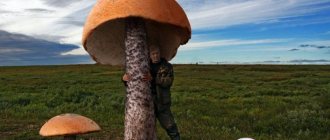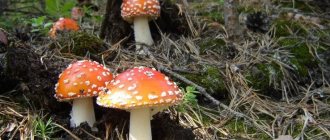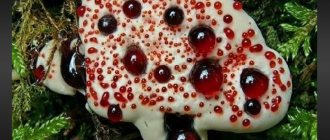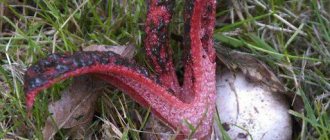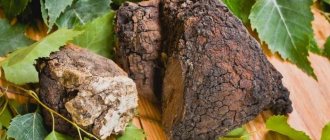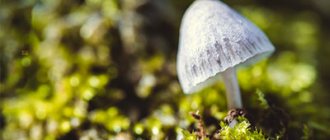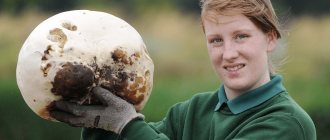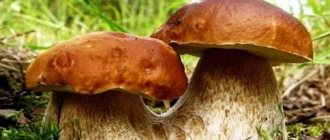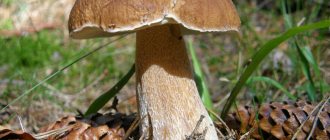Author: Great Mute
23 September 2022 20:16
Community: Facts
Tags: stories nature facts photos
5130
5
The blue whale, the largest animal known to mankind, is not, contrary to popular belief, the largest living creature on the planet. Number 1 bears the laurels of the giant... We read the details and add him to our piggy bank of the MOST...
0
See all photos in the gallery
This is a MUSHROOM, or rather, the mycelium of the dark honey fungus (Armillaria ostoyae), which develops in the Malheur Forest Reserve in the US state of Oregon. The mycelium of this living creature covers an area of more than 880 hectares, and its age is estimated at 2.4 thousand years. The largest living organism on the planet is sometimes called the Oregon monster or the honey mushroom monster, and not at all because of its gigantic size. The fact is that the giant mycelium, entangling the roots of trees, causes the death of the latter. And many of the trees in the reserve have already become victims of huge mycelium. By the way, it was thanks to the massive death of trees that the giant was identified.
0
Attracted by the history of the death of trees, biologists in 1998 were able to determine that the honey fungus mycelium from Oregon is not individual clusters growing throughout the forest, but a giant, integral living organism. Previously, the largest living creature in the world was considered the mycelium of the dark honey fungus, growing in Washington state. Its size was estimated at 600 hectares. It is possible that there are larger myceliums on our planet, the existence of which is still unknown to scientists.
×
Description of edible mushroom
Dark honey fungus is also called Ground mushroom, hard spruce honey mushroom or honey mushroom.
It belongs to the genus honey mushrooms of the Physalacriaceae family. It bears the Latin name Armillaria ostoyae or Armillariella ostoyae. Its cap is convex, but can be flat, red-yellow or brown, the entire surface is covered with scales of a darker shade, the center is brighter in color. The edges have remnants of a white blanket that look like fringe. It reaches 10 cm in diameter.
The hymenophore - the lower part of the cap - is a series of plates, located quite sparsely, fused. At first they are white, with a slight yellowish tint, later they become darker, with a more intense color. The spores are white.
The pulp has a loose structure, white, sometimes with a yellowish tint.
The stem matches the color of the cap and wears a well-defined ring with fringe. There is a thickening at the bottom. There is no smell. Grows up to 12 cm in length.
A little history
The first to speak about the dark honey mushroom was the French mycologist Henri Charles Louis Romanesi, and a little later, in 1973, the Czech mycologist who was involved in the systematization of mushrooms, Joseph Heinrink, determined the genus and family of this species. In the scientific classification, the spruce honey fungus is still in the same family and genus.
The most gigantic living creature on Earth
Scientists consider mushrooms to be the most diverse living creatures on our planet. There are so many of them that for each type of plant there are 6 types of mushrooms; with the most approximate calculation, it turns out that there are about 2 million species of mushrooms. They can be predators, move around, treat diseases. At the same time, only 100 thousand have been studied, and even less have been classified. mushrooms are an independent kingdom. The long debate about whether mushrooms are plants or animals ended in 1960, when they were separated into a separate kingdom of fungi. In terms of protein content, mushrooms are closer to animals, and in terms of the composition of carbohydrates and minerals - to plants. Most of the mushroom is not visible to us. The body of the mushroom is the mycelium located in the ground. It can extend over vast distances. And the mushroom itself is a fruit intended for the implementation of a reproduction program. mushrooms are older than dinosaurs. It has been proven that mushrooms existed 400 million years ago, that is, long before the appearance of dinosaurs. They are one of the oldest inhabitants of the planet, along with ferns. But if the giant ferns that survived from the same period were significantly reduced, then the mushrooms, adapting, changed and, it seems, all these species still exist. mushrooms are very tenacious. If mushrooms were less tenacious, they would not retain their diversity. Anyone who has ever suffered from a fungal infection or struggled with fungal damage to walls can imagine how tenacious they are. It is extremely difficult to remove the fungus. Still would! Mushrooms survive at an altitude of 30 thousand meters above the ground, withstand high radiation (mushrooms survived at the center of the Chernobyl accident) and pressure of 8 atmospheres. They can even live on the surface of sulfuric acid! mushrooms sunbathe. Surprisingly, mushrooms produce vitamin D, if, of course, they have enough sunlight. The color of the mushroom cap depends on this. mushrooms move. Not all, of course. Currently, only myxomycetes are classified as “walking” mushrooms. You can find them in central Russia. This mushroom does not have a stem and in appearance resembles a shrunken jellyfish. It is translucent and gelatinous. Moves by waddling from side to side. The speed is low, but it can get to a more suitable place in a few days, sometimes even climbing a stump. the mushroom grows at the speed of bamboo. In Russian forests you can find a mushroom called “Veselka”, which is included in the Guinness Book of Records as the record holder for the fastest growth rate. Every 2 minutes it grows by a centimeter! On the first day it looks like a grayish egg, on the second it becomes an umbrella on a high leg, and on the third it is no longer visible. The mushroom is the most gigantic living creature on Earth. Don't believe me? A very large white mushroom was found in America (Wisconsin) in 1985. It weighed 140 kg and had a reach of two meters. But, as we remember, this is only the visible part. A mycelium was found in Oregon, covering an area of 900 hectares and weighing several hundred tons! But in Switzerland they discovered a mushroom about 1000 years old - honey fungus. Its mycelium occupies 35 hectares of the Swiss national park in Ofenpass. mushrooms are predators and killers. Fungi feed on nematode worms, setting traps for them from mycelium rings. If a worm touches such a trap, it sticks to it and immediately becomes entangled in the threads of the mycelium. There is no chance of escape. Fungal spores can germinate inside living things. But if a person gets sick, then the caterpillar, for example, dies. And the mushroom develops. One small toadstool is enough to kill 4 people. But you will need several fly agarics. Potent poisons were prepared from mushrooms and were actively used to eliminate opponents. Emperor Claudius was poisoned by his wife Agrippina by making toadstool soup. mushrooms are healers. Mushrooms have been used as medicines since ancient times. Even now, in many homes, “tea” or “milk” mushrooms grow in jars, a drink from which improves immunity and fights inflammatory diseases. In 1940, A. Flemming isolated penicillin from yeast fungi, opening the era of antibiotics. Champignons, violet rows, meadow and autumn honey mushrooms, milkweed, and chaga have medicinal properties. And the skin of raincoats is used instead of an adhesive plaster - its inner part is sterile and has bactericidal properties. Most Russians eat mushrooms . Half of Russian residents collect mushrooms for food on their own. Every fifth person buys them on the market. 16% - in the store. 14% of Russians have never eaten mushrooms and do not plan to do so. mushrooms are a valuable nutritious product. Mushrooms are a source of protein and, to a lesser extent, carbohydrates, and contain absolutely no cholesterol. By the way, precisely because mushrooms do not contain animal saturated fats, they cannot be classified as animals. In addition to protein and carbohydrates, mushrooms are rich in vitamins B1, B2, D, selenium, potassium and antioxidants . Mushrooms are hallucinogens. Many mushrooms contain substances that cause euphoria and hallucinations. The ancient shamans and Vikings knew this. Shamans used this property of mushrooms to perform rituals, and the Vikings used it to give themselves courage and attack the enemy with all fearlessness and power. billions of fungal spores fly in the air. Fungi reproduce by spores. By taking air samples in almost any room, you can detect fungal spores. If we talk about traditional mushrooms, then an ordinary champignon releases up to 40 million spores! Dung fungus – 100 million spores. The record holder is the puffball mushroom, which releases more than seven trillion spores! In this case, the spores are thrown at a distance of more than two meters and they fly at the speed of a car: 90 km/h or 25 meters per second. the mushroom can “pierce” the marble. During the growth period, the pressure of the fungus reaches seven atmospheres (equal to the pressure in the tires of a dump truck). Therefore, a seemingly soft mushroom cap can break through not only asphalt and concrete, but also harder surfaces such as marble and iron. If the cap itself does not pass, then the mycelium will gradually destroy the barrier. mushrooms are taller than trees. These mushrooms grow in the tundra. The trees there are dwarf, 20-25 cm high and bend to the ground. And the mushrooms are standard, so they rise above the treetops. It is interesting that they grow almost at the same time, rushing to release spores during the short summer, and they present a very spectacular view. Most of all, this period pleases the deer, who happily eat the caps of these mushrooms. mushrooms glow in the dark. Some mushrooms have luminous mycelium. For example, autumn honey fungus growing on rotten stumps. At the same time, the mycelium penetrates the stump thickly. In the dark you can see how the rotten ones glow - phosphorescent. This sight used to greatly frighten people, who immediately populated the forest with witches and goblins. What’s interesting is that the flickering of such lights resembles the movement of living beings, as it changes with every tilt and every turn of the head. mushrooms ladies and gentlemen. It turns out that mushrooms are divided into male and female. This is evidenced by the structure of fungal DNA, which resembles human sex chromosomes. This was reported by Joseph Heitman, who studies the fungi Phycomyces blakesleeanus at Duke University Medical Center. Sexually mature mushrooms can produce common offspring. Not all mushrooms have similar genes, which means that among mushrooms there are also evolving individuals, and who knows what such evolution will lead to. mushrooms in legends, traditions and dream books. It is interesting that in those places where mushrooms grow actively, including in Russia, there are many legends and traditions involving mushrooms. At the same time, mushrooms can be good: “Forest Mushroom” and evil: “Witch’s Mushroom”. Mushrooms helped people survive in the forest.
| source |
The largest mushrooms in the world
If you ask people, then to the question “What is the largest creature on Earth,” almost everyone will answer that it is a blue whale. Some scientists even claim this. But they are only partially right. Yes, the blue whale is a large animal. But the largest creature living on earth is the mushroom. Moreover, it has been on the planet for several thousand years. In fact, mushrooms are amazing creatures of nature. They differ from animals in physiology and the inability to move independently, but from plants in that they do not take energy and carbon from carbon dioxide and sunlight. Moreover, mushrooms typically contain chitin, which is found in invertebrates. Mushrooms are a huge kingdom of living beings. Today people know about one hundred thousand mushrooms, and some of them bring a lot of benefits to humanity. Here we should not forget about antibiotics and penicillin. Well, besides medicine, mushrooms are used as food. Almost all mushrooms grow in the form of a community of cells, which gathers into a thread of mycelium. And when they grow into a plant, they can develop a pressure of 800 tons per square meter. And these same mushroom threads play the role of the mouth and stomach of mushrooms. They release enzymes that break down potential food into components and eat the nutrients. It turns out that mushrooms grow inside the food they eat. By the way, when you cut a mushroom above the ground, a whole mycelium remains underneath it. The mycelium is an invisible, but very large part of the mushroom. Meanwhile, desperate botanists and the most sophisticated gourmets are in shock. The size to which mushrooms can grow can be so impressive that no questions arise after what you see. It is unknown what factors can provoke the growth of fungi to unimaginable sizes. But it is clear that such anomalies are extremely rare; at least, only a few cases are known today. Mushrooms can grow to incredible sizes. Monster Mushroom The general public first learned about the giant Armillaria mushrooms only on April 2, 1992. One of the record holders ended up on the front page of the most popular newspaper, the New York Times. The publication described the discovery, according to reports, the interweaving of underground threads and above-ground mushrooms covered as many as 15 hectares of land. And all this was a single whole, which experts were able to prove. Armillaria - small mushrooms with a huge mycelium. In the same year, another giant mushroom of the same species was found. It occupied a space of approximately 6 square kilometers. But even he was not the real record holder. The largest mushroom on the planet grew in Malheur National Park in Oregon in the Blue Mountains. “Mushroom” covered an area of 890 hectares, which is approximately 1220 football fields. Scientists even calculated how long it took him to grow so huge. It turns out that the mushroom is at least 2400 years old. It belongs to the species Armilaria ostoyae, and is also known as a honey mushroom. However, you definitely cannot make soup from such a record holder, since it is inedible. On the surface, the mushroom leaves only dead trees and small mushrooms, the rest is underground.
The oldest mushroom in the world
Armilaria ostoya has been living for almost 2.5 thousand years. This mushroom is a well-known and widespread species of real honey mushroom. At the same time, this find is a parasitic fungus that damages trees throughout the Northern Hemisphere of our planet. It lives in the soil and mainly spreads along the roots of trees, introducing mycelium threads called resoids into the thickness of the wood. “This is a single organism that begins its growth as a microscopic spore and then spreads like a plant,” say experts, “and if we could remove the bud and look at everything that remains, we would see a large single pile of one mushroom with all the threads mycelium."
Giant mushrooms
But the largest edible mushroom was found by a certain Jean Guy Richard in Canada. In his basket was a unique raincoat (Calvatia gigantean). And he was truly gigantic. The mushroom weighed exactly 22 kilograms and was 2.64 meters in circumference. A giant mushroom weighing 22 kg However, the Mexicans are truly lucky. In the summer of 2007, a mushroom weighing approximately 20 kilograms and more than 60 centimeters long was found on coffee plantations in the state of Chiaps in southeastern Mexico. It is noteworthy that he grew right among the coffee trees. Another edible record holder, which was found in Italy, weighed 14 kilograms. It was discovered by Francesco Quito in the province of Bari. And it was champignon. To bring such a find home, the mushroom picker had to look for a car.
The largest mushroom in Italy
Well, the previous giant mushroom turned out to be a truffle. True, he weighed a little less than his predecessors, only 7 kilograms. And the most interesting thing is that the people who found the mushroom did not find anything better than to fry their find and eat it with their neighbors. And this is taking into account the fact that mushrooms in Italy are valued quite expensively, so the forest miracle could be sold profitably. Another natural miracle was found in the forests of Switzerland. An interesting fact: the huge mushroom turned out to be a simple mushroom. Scientists were truly amazed by its size, because no one had ever suspected that mushrooms such as honey mushrooms could become giants. And in fact, the size of the mushroom can inspire respect. Its length is 800 meters and its width is about half a kilometer. Its size covered 35 hectares. In principle, his age is not small, according to the most conservative estimates, one thousand years.
The largest mushroom in the world
In 2011, there were reports that scientists from the Chinese Academy of Sciences on Hainan Island discovered a mushroom weighing approximately 402-516 kilograms. Since then, it has been called the largest mushroom on the planet. Yu Cheng Dai and his colleagues made the discovery completely by accident. The company went on an expedition with one goal - to study representatives of the mushroom kingdom as a whole, they were especially interested in those that, of course, are found in the forests of their native island. The largest mushroom in the world was found in China. It was Fomitiporia ellipsoidea. The mushroom was assigned to the species Fomitiporia ellipsoidea, and its age was estimated at 20 years. Over the years, he managed to grow almost 11 centimeters in length, 88 centimeters in width and 5 centimeters in thickness. The mushroom has an unprecedented volume - 409-535 thousand cubic centimeters. However, three years earlier, also in China, but on another island of Fujian, similar huge mushrooms were discovered, although they were very different in size from their counterpart from Hainan.
Growing at home and in the country
Modern science allows you to grow honey mushrooms in your own backyard; you don’t need to look for an old honey mushroom and wait a long time for the spores to find the right tree and germinate.
It is enough to purchase mushroom mycelium and fulfill the necessary conditions for growing agricultural technology.
In order to grow honey mushrooms on your site, it is enough to choose a tree that you don’t mind, because this organism will destroy it completely; a rotting or dying plant is best suited.
After thoroughly wetting, plant the mushrooms and cover them with moss so that the moisture does not evaporate for as long as possible. It will be even better if the place where they are planted is shady. After a year, you can harvest the first harvest, which will appear for 7 years.
For growing in city apartments, you can use glass jars; you will also need:
- a third of the capacity of bran;
- two thirds of sawdust from deciduous trees;
- starch and flour 1 tbsp. l.
To grow you need:
- Pour all the ingredients into a container, add water and boil.
- Cool, pour into jars and plant mushrooms there.
- Close with a lid that has a hole for air access.
- When the first fruits appear, the covers need to be removed.
In just a month the first honey mushrooms will appear.
When and where to collect
For people who study mycology, honey mushrooms are a constant headache. After selection among a huge number of mushrooms, which are called honey mushrooms, two, and perhaps even three completely new species of these mushrooms are distinguished from one species, and more and more new signs of difference are discovered. This is a pattern. Honey mushrooms are so amorphous and unpretentious that even distinguishing between species that have been known for quite a long time can be very, very difficult. For example, the thick-legged honey mushroom was previously considered an autumn honey mushroom, until it was noticed that despite the general similarities that can be traced between them, there are some striking differences.
Firstly, the growing season is different, and secondly, the places where they settle, the thick-legged honey agaric never grows on wood (living), as a rule, it does not grow on such a tree at all. Large areas are covered with a yellowish blanket. So, let's look at the biological description of this fungus. As for the cap, in early mushrooms it has a spherical shape, but over time and growth, it opens to a fairly decent prostrate state, but the edges remain bent. The color range fluctuates towards a grayish-yellow color.
Interesting read: How to distinguish fringed galerina from honey mushrooms
The size of the cap reaches five to six centimeters in diameter, the cap is quite massive. Speaking about the plates, it is worth noting that they are white-yellow in color; over time, their color changes to brown with characteristic dark spots. The leg is dense, fibrous, slightly thickened at the base, it is lighter than the cap. There is a ring on the leg. Mushrooms grow in colonies. Often found in forests.
The size of mushroom families is impressive. Places of settlement are both on dead wood and on the forest floor. In addition to the fact that the mushroom is extremely prolific, it is also surprising in its consistency. Thus, if you find a colony of mushrooms, remember this place, in a year you can come there and find a colony of these mushrooms twice as large.
Where thick-legged honey mushrooms grow.
As for mushrooms with similar characteristics, it is very difficult to confuse this mushroom with other relatives, since these mushrooms do not have inedible/poisonous relatives similar in external characteristics. As a rule, they can be confused with autumn honey mushrooms, or rather, they belong to the same species.
What's the difference? The fact is that they do not grow together at start-ups, but spread out in a continuous layer. Collection time: August (July) – October (November). The peak is October, in contrast to autumn honey mushrooms, which are collected in September. Thick-legged Honey fungus is one of the most delicious mushrooms. It is quite often grown in industrial conditions. All standard types of culinary processing are applied to such mushrooms.
Honey Mushroom False Doubles
Like many edible fruits, dark-capped honey mushrooms have their own counterparts. Some of them are edible, others are not.
| Name | hat | Leg | Danger |
| Ground honey fungus | Yellow or brown with a reddish tint | These honey mushrooms have a dark stem that matches the color of the cap. | Edible |
| False honey agaric | Bright, gray-yellow | The leg ring is missing | Inedible |
| Honey fungus swollen | Brown with yellowish or ocher hues | At the bottom the leg is swollen, brown, above it is light yellow | Edible |
| Autumn honey fungus | Colored in honey, brown and even greenish shades | Yellow-brown, darker below, covered with flakes | Edible |
As can be seen from the table, these mushrooms do not have poisonous counterparts; they are the darkest honey mushrooms. It is very easy to distinguish them, but care when collecting will not hurt.
Fish recognizing human faces
Squirting fish, found in the tropics, can recognize people's faces! Studies were conducted in which scientists found that these fish were able to recognize 80% of the people whose faces they had seen before.
Prayer to be read at home on Parents' Saturday, March 27
Apple will release its new iPhone 13 at the end of September
Pastels and flowers: how to wear the most fashionable shades and prints of spring for women 50+
Evaluation of taste qualities, medicinal properties, benefits and possible harm
Mushrooms are often called vegetable meat, and their calorie content is minimal. Dark honey mushrooms contain a large amount of glycogen, vitamins, microelements, as well as organic acids, sugar and ash. The phosphorus content in them is higher than in cow's milk, and the potassium content is the same as in pears. Half of the dry mass is fiber.
The pulp of spruce mushrooms is quite hard, which means it will be difficult to digest. Should not be consumed by elderly people or those suffering from gastrointestinal diseases.
Important! Children under three years of age, pregnant and lactating women are prohibited from eating mushrooms.
Dark honey mushrooms are used to treat tumors, during antibacterial therapy, and diseases caused by Escherichia coli or Staphylococcus aureus. Able to normalize the functioning of the thyroid gland.
In addition, they help remove cholesterol and prevent it from remaining in the blood vessels, and the low glycemic index allows them to be consumed by patients with diabetes.
Cooking recipes
The bodies of dark mushrooms contain a little water, they are perfect for frying, but the legs are often not used for food, as they are very hard, especially in older specimens. Because of their love for coniferous trees, honey mushrooms can be a little bitter, but boiling them gets rid of this.
These mushrooms are salted, pickled, dried and frozen - they are suitable for any processing.
Primary processing
Preliminary preparation for further preparation consists of cleaning the fruits from forest debris, they should also be washed under running water and boiled for 20 minutes, draining the water after that.
Cooking
To boil mushrooms, you only need the fruits themselves, water and salt to taste. It is enough to boil the honey mushrooms in salted water twice for 20 minutes, changing the water between processes for a new one. After this, they can be cooked further or added to soup.
Pickling
For marinating, boiled honey mushrooms are used; you will need:
- mushrooms – 1 kg;
- salt – 2 tbsp. l.;
- sugar – 1 tbsp. l.;
- vinegar - 2 tbsp. l.;
- cloves – 2 buds.
Cooking process:
- Pour 1 liter of water into a saucepan, add salt and sugar, bring to a boil.
- Pour in vinegar and add cloves.
- After 2 minutes add mushrooms.
- Cook for 15 minutes.
- Place the fruits in prepared jars and pour marinade over them.
The jars should be cooled, covered with lids and placed on the bottom shelf of the refrigerator.
Freezing
Boiled mushrooms are frozen. They should cool completely and all the water should drain off. After this, the fruits are distributed into portioned containers or bags and sent to the freezer.
Important! If you freeze a large number of mushrooms in one container, then it will be difficult to separate them and get the required amount for cooking.
Frying
To make delicious mushrooms with sour cream, you will need:
- boiled honey mushrooms – 0.5 kg;
- sour cream – 5 tbsp. l.;
- onion – 300 g;
- fresh dill – 100 g;
- butter – 50 g;
- salt and pepper to taste.
Cooking process:
- Finely chop the onion and fry in a frying pan until soft.
- Add mushrooms, butter, stir, salt and pepper.
- After 5 minutes, add sour cream.
- After boiling, add finely chopped dill.
- After 2 minutes, remove from heat.
These mushrooms are best served with boiled potatoes.
Pickling
For salting, you will need previously prepared dark mushrooms, boiled in salted water. Besides:
- mushrooms – 2 kg;
- salt – 100 g;
- garlic – 6 cloves;
- black allspice – 10 peas;
- dill - 2 umbrellas.
Cooking process:
- Prepare a deep enamel bowl, line the bottom with salt, a layer of mushrooms on top, continue alternating.
- Each layer should be sprinkled with garlic, pepper and dill.
- Cover everything with gauze in two layers, press with a plate and place a weight on top.
- After 10 days, you can try the finished mushrooms.
During this time, you should periodically wash the gauze or replace it with a new one; this will preserve the harvest and prevent it from becoming moldy during the pickling process.
At the end, the mushrooms are placed in jars and closed with lids. You can store it in the refrigerator, cellar or basement.
Drying
In order to dry honey mushrooms, you should not wash or boil them. It is enough to remove debris with a soft brush and remove rotten and wormy specimens.
Mushrooms should be cut so that they are all the same size, this will allow them to dry equally intensively.
Then string all the parts on a thread and hang them in a sunny place, in a well-ventilated room or on a balcony or in the garden.
It is better to cover the top of the fruits with several layers of gauze, this way you will avoid infection by insects and dust settling.
After a week, in sunny weather, the mushrooms will be completely dried. They can be stored in a dry place, away from foreign odors.
Canning for the winter
To preserve mushrooms for a longer period you will need:
- dark boiled honey mushrooms – 1 kg;
- vinegar - 2 tbsp. l.;
- salt – 2 tbsp. l.;
- sugar – 1 tbsp. l.;
- laurel leaves – 3 pcs.;
- garlic – 5 cloves;
- black peppercorns – 10 pcs.
Cooking process:
- Add salt, sugar to 1 liter of water and bring to a boil.
- Then add bay leaf, garlic, pepper and cook for 3 minutes.
- Add mushrooms, boil for 5 minutes.
- Add vinegar, cook for another 5 minutes.
- Place the fruits in sterilized jars and fill with marinade to the top.
- Sterilize the jars for 20 minutes, then roll them up.
Such mushrooms will be stored for a long time and will delight you throughout the long winter.
Giant honey fungus growing in the Malure Nature Reserve in the US state of Oregon
US scientists have discovered a giant honey mushroom, the largest living organism on earth, in the Malheur Nature Reserve in Oregon. He is rightfully considered the largest living creature on the planet, because. the mycelium occupies an area of more than 880 hectares, and the age determined by mycologists is more than 2.4 thousand years.
Sometimes it is even called the Oregon monster, because its mycelium, feeding on trees, envelops their roots, spreads under the bark and as a result the plants die.
Biologists first noticed the mass death of trees in 1998, which led to a study of the causes. It turned out that the mushrooms growing throughout the entire area are not individual specimens, but a single giant organism.
Dark honey mushrooms are tasty and healthy forest gifts that are easy to distinguish from their counterparts and are easy to prepare. You should carefully collect the forest harvest so that poisonous specimens do not end up in the basket; for this, you should not collect unfamiliar fruits. Spruce mushrooms are easy to distinguish from their counterparts, their taste is highly rated, and their popularity has not fallen for many years.
